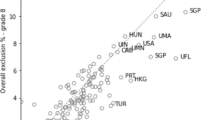Abstract
This study contrasts the distributions of indices of academic abilities and achievements of entering freshmen classes and of classes at the end of the first year of college over an eight-year period. The data reported are based on two groups of students: one comprised of all students who completed the ACT Assessment Program and subsequently enrolled in college, and the other group comprised of all students in the first group completing their first year of college. Data collected show a decline in ACT test scores, an increase in the high school grades of college entrants, and the stability of test scores and increases in college grades of freshmen completing their first year of college.
Similar content being viewed by others
References
The American College Testing Program. (1973). “Assessing Students on the Way to College. Vol. 1: Technical Report for the ACT Assessment Program.” Iowa City, Iowa: The American College Testing Program.
Astin, A. W. (1975). “Preventing Students From Dropping Out.” San Francisco: Jossey-Bass.
Astin, H. S., Astin, A. W., Bisconti, A. S., and Frankel, H. H. (1972). “Higher Education and the Disadvantaged Student.” Washington, D.C.: Human Press Service.
Baird, L. and Feister, W. J. (1972). Grading standards: The relation of changes in average student ability to the average grades awarded. Am. Ed. Res. J. 9:431–442.
Bureau of Labor Statistics. (1974) Employment of high school graduates and dropouts, October 1973: Special Labor Force report 168. Washington, D.C.: U.S. Department of Labor.
Burwen, R. (1971) “A National Survey of Institutional Grading Practices.” San Francisco: Office of Institutional Research, San Francisco State College.
Calhoon, R. P., and Reddy, A. C. (1968). The frantic search for predictors of success. J. College Placement 28:54.
College Entrance Examination Board. (1975). College-bound seniors, 1974–75.” New York College Entrance Examination Board.
Cross, K. P. (1971). “Beyond the Open Door.” San Francisco: Jossey-Bass.
Fenske, R. H., and Scott, C. S. (1973). The changing profile of college students. ERIC/Higher Education Research Report no. 10. Washington, D.C.: The American Association for Higher Education.
Ferguson, R. L., and Maxey, E. J. (1975). Trends in the academic performance of high school and college students. Unpublished paper presented at the American College Personnel Association, March.
Grade inflation. (1974) Newsweek 84 (1):49.
Hawes, G. R. (1972). The decline of the SATs. Change 9 (4):17–19.
Heckman, R. W., Banas, P. A., Lazenby, R. E., and Moore, L. M. (1969). Biographical correlates of management success. Proc. 77th Ann. Conven. Am. Psychol. Assoc. 4:611–612.
Hoyt, D. P. (1965). The relationship between college grades and adult achievement: A review of the literature. ACT Research no. 7. Iowa City, Iowa: The American College Testing Program.
Hoyt, D. P. (1970). Rationality and the grading process. Ed. Rec. 51 (3):305–309.
Lavin, D. E. (1974). Open admissions at the City University of New York: A description of academic outcomes after two year. New York: Office of Program and Policy Research, City University of New York.
Maxey, E. J., and Ormsby, V. J. (1971) The accuracy of self-report information collected on the ACT test battery: High school grades and items of nonacademic achievement. ACT Research Report no. 45. Iowa City, Iowa: The American College Testing Program.
Munday, L. A., and Davis, J. C. (1974). Varieties of accomplishment after college: Perspectives on the meaning of academic talent. ACT Research Report no. 62. Iowa City, Iowa: the American College Testing Program.
Rivlin, A. (1975). “Income Distribution: Can Economists Help?” Washington, D.C.: Brookings Institution, 1975.
Rossman, J. E., Astin, H. S., Astin, A. W., and El-Khawas, E. H. (1975). “Open Admissions at City University of New York: An Analysis of the First Year.” Englewood Cliffs, N.J.: Prentice-Hall, 1975.
Trow, W. C. (1968). Grades and objectives in higher education. Ed. Rec. 49:85–91.
United States Office of Education. (1965; 1972). “The Education Directory; Part III: Higher Education.” Washington, D.C.: U.S. Government Printing Office.
White, E. M. (1975). Sometimes an A is really an F. Chronicle Higher Ed. 9(18):24.
Author information
Authors and Affiliations
Rights and permissions
About this article
Cite this article
Rever, P.R., Kojaku, L.K. Access, attrition, test scores, and grades of college entrants and persisters: 1965–1973. Res High Educ 5, 289–299 (1976). https://doi.org/10.1007/BF00993428
Issue Date:
DOI: https://doi.org/10.1007/BF00993428




